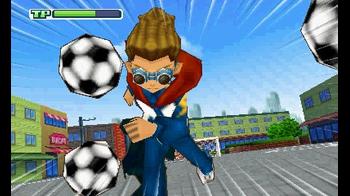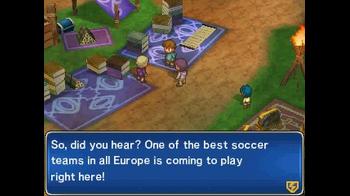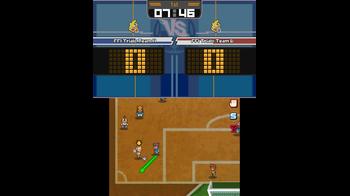
Inazuma Eleven 3 Review
Growing up in Britain I think it's largely impossible to not leave your childhood with an extensive knowledge of football, or soccer, as some will undoubtedly shout. I can personally take or leave the game; there's other sports I prefer - but still the knowledge I have of the football and how loved it is in the country and the world is pretty incredible. That fact alone makes the Inazuma Eleven series a potentially massive one for Nintendo - football made friendly with an RPG twist, the games could easily have massive popularity.
When Nintendo sent RPG Site a copy of Inazuma Eleven 3 for the 3DS I'd never actually played the series before. It had been pitched to me by a friend as a football management game merged with the light touch but still deep RPG mechanics you'd find in Pokemon - and that had me very intrigued indeed.
The Pokemon comparison is certainly a good one. This has the same feel, a game that's designed to be kid-friendly with excitingly-haired anime characters and RPG mechanics that appear simple and manageable, then with a surprising amount of depth lurking away behind that.
This entry in the series even copies the two-game Pokemon style of release - there's Lightning Bolt and Bomb Blast versions of the game, each essentially the same core game with subtle changed to side quests and teams you play to provide a difference between the games. So far, so Pokemon.
The game's story places you in command of Inazuma International, an under-15s football team representing Japan. They've been picked to go and represent their country in a high-stakes International tournament - and to cut a long story short the team wants to prove that they're the best youth talent on the planet. The only way to do that is by playing and winning.
As in any good RPG, this typically epic storyline is punctuated with more personal moments and interjections about the stories and relationships surrounding various major characters on the team. Some side stories are clearly merely distractions to lengthen the game, while others weave in and out of the core tournament story throughout the entire game with surprising deftness.
One thing the series doesn't lift from Pokemon is simplicity of plot and the lack of a need for continuity. Inazuma Eleven as a series consists of a number of games - some of which didn't get a Western release - and an anime show, which mercifully has been localized if people want to track it down. I've not played any of the other games or caught a single scene of the anime, and in places that did cause mild problems.
On occasion a level of knowledge about characters, relationships and past events I simply didn't have is assumed, and I was left scratching my head. The writing is kept largely simplistic to keep the game accessible to kids, and as such characters are thankfully sketched in a very broad fashion - so it isn't too difficult to get caught up; the game could just definitely handle it better.
The quality of the writing seems to jump around a bit, and in general there's not quite the steady hand here that's been on show in the translation of other Nintendo games that are kid friendly in their simplicity and adult friendly in the challenge they provide. The story plays out in old-school RPG fashion through in-game text - though occasional anime sequences boost major story moments.
Those well-animated video sequences are probably the visual highlight of the game, as while it looks good there's really nothing to write homw about in Inazuma Eleven 3. In Japan the game was a 3DS title, and given the lengthy gap between release there and localization, Nintendo saw fit to bump it up to more current hardware.
The 3D effect is barely used to any notable effect, and the game is played mostly on the non-widescreen bottom screen. It's an isometric sprite-based title from the last generation of handheld hardware, and it shows in not being bad, but being just a little bit dated - so it's a good job the core game is good.
As in real life, a good chunk of football in Inazuma Eleven is about how you prepare for matches before you play them - and it's here that the RPG side of the game fully rears its head. The core team of players is a squad of eleven, and while the game's story will thrust a good number of characters to choose from in your lap, you can also recruit others through scouting.
Here, scouting takes the form of a capsule vending machine - you feed coins into it, and out pops one of around 2000 players. There's a a ton of different players in the two versions of the game, and the two can of course wirelessly trade if you've a friend playing as well. While perhaps more useful for multiplayer, drafting players ends up feeling a bit redundant, as the core story squad always outstripped any drafted players I picked up in quality by a large margin.
Developing players, be it the story squad or drafted players, is a satisfying process. Eventually when the time comes you'll select a squad and trot you chosen eleven out onto the pitch for a match. In RPG terms these are your battles, though they're so big and important they're more like boss encounters. Rather than an action-based take on football, this is a strategy-driven style, with the most important thing you're tasked with doing setting up where on the pitch players will run to get positioning right by drawing on the touchscreen.
You're simply moving players around the pitch and setting up where they stand, where they dribble the ball, and where and how they pass it on. When the time comes you'll want to take a shot, and when the tables are turned you'll be trying to move players to block and reverse your opponent's attack.
All of these areas are where your player's full RPG statistics come into play, as they effect how well they'll perform certain actions and work within certain roles out on the pitch. All of this is accomplished on the bottom screen - in fact, the lion's share of the game is played down there.
In addition to the skills that make up most of the moment-to-moment play, characters are also equipped with special moves for things like shooting, tackling, dancing around opponents with the ball and more. These are limited, so how and when you deploy them is a major tactical consideration.
Some of these skills can also be used to counter when your opponent uses one of their own, so they're not all about offence. It's in choosing what abilities to use and when that this really starts to feel like a proper sports and RPG mash-up - and it works well.
Outside of full matches, team captain and protagonist Mark can take three more members of his team with him out with him in downtime. In this you'll get to experience some of the side quests and the like, but there's also smaller four-a-side matches you'll be thrust into here. These are like your random encounters, short matches with specific objectives that offer additional chances to level up. You can also go back and challenge teams you've already defeated again to attempt to persuade their players to join your squad.
The problem is even with all this on offer, downtime between the real big event matches begins to pile up and, sadly, become boring. I found myself desperately wanting to just skip ahead to the next big exciting game, and that's Inazuma Eleven 3's greatest downfall. It has an amazing 'battle' system with its matches, but it isn't quite feature rich enough outside them to really grab me completely.
Inazuma Eleven 3 is a fun title, and full football matches in it are exciting, exhilarating and tactical. This is a good game with the glint and glisten of a franchise that with development and growth could become really, truly great. As such, this one is definitely worth a look, and the series in general feels like one to watch.


